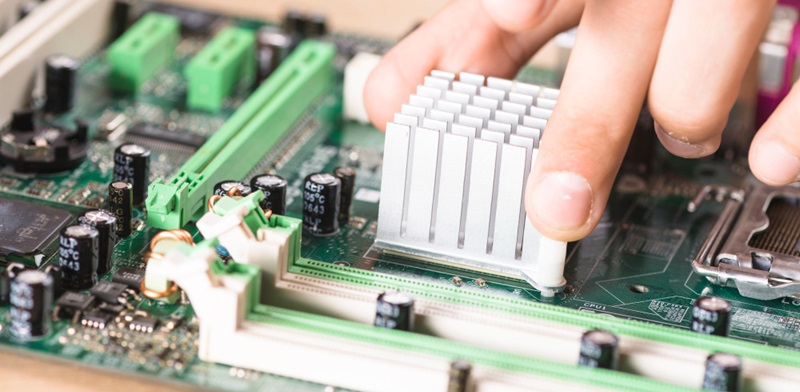In the world of PC building, enthusiasts are always striving for the most efficient and groundbreaking solutions. One Redditor has recently made waves in the community by successfully constructing a passively cooled PC rig that defies conventional methods. This remarkable build features a combination of cutting-edge components, including a Ryzen 7 7700X CPU, an RTX 4060 GPU, and Noctua NH-P1 heatsinks. What sets this build apart from the rest is its complete absence of fans, making it a truly silent beast.
Components of the passive cooling PC
The heart of this passively cooled PC is the Ryzen 7 7700X CPU. Renowned for its exceptional performance, this processor operates at a base clock speed of 3.8GHz and can reach up to 4.2GHz with boost. The Redditor chose this CPU due to its relatively low power consumption and excellent thermal capabilities.
Accompanying the CPU is the RTX 4060 GPU, a powerhouse in its own right. With its exceptional graphics performance, the RTX 4060 promises an immersive gaming experience and excellent graphics rendering capabilities. However, the challenge of using a high-end GPU like this in a passively cooled build lies in managing the heat generated.
To tackle this issue, the Redditor employed Noctua NH-P1 heatsinks, known for their exceptional heat dissipation properties. These passive heatsinks were skillfully attached to the GPU, effectively providing the necessary cooling without the need for fans. This clever solution ensures that the RTX 4060 stays within acceptable temperature limits for reliable and consistent performance.
Defying conventional methods
What is truly astonishing about this passively cooled build is its complete lack of fans. In a traditional PC cooling setup, fans play a crucial role in dissipating heat and maintaining safe operating temperatures. However, this Redditor’s innovative approach demonstrates that with careful planning and optimal component selection, it is possible to achieve efficient cooling without relying on fans.
Utilization of 3D-printed brackets
To properly implement the passive cooling solution, the Redditor utilized 3D-printed brackets. These brackets served multiple purposes – they provided a secure mounting system for the Noctua NH-P1 heatsinks, ensured proper contact between the heatsinks and the CPU/GPU surfaces, and maximized heat transfer efficiency. By leveraging 3D printing technology, the Redditor was able to customize the brackets specifically for this unique build, further optimizing its cooling potential.
Demonstrating support for modern-day components
One of the most significant achievements of this passively cooled PC build is its ability to support modern, high-performance components. Many skeptics argue that passive cooling is only suitable for low-power builds or older hardware. However, this Redditor’s creation challenges such assumptions. By carefully selecting components with lower TDP and maximizing the cooling potential through precise heatsink positioning, this build successfully demonstrates the capacity of passive cooling to handle modern-day hardware.
Polishing the setup: TDP adjustment and Eco mode
To achieve the desired temperatures, the TDP of the RTX 4060 needed to be adjusted. The Redditor lowered it to 90W, striking a balance between performance and temperature control. This adjustment ensures that the GPU operates within safe thermal limits, preventing any potential damage or performance degradation.
Similarly, the Ryzen 7 7700X CPU was set to “Eco Mode” with a lowered TDP and temperature limit. This cautious approach ensures that the CPU remains cool and stable under heavy workloads, even without the assistance of fans. By making these adjustments, the Redditor achieved a fine balance between performance and cooling efficiency.
Motherboard and memory specifications
The passively cooled PC build relies on an MSI B650I Edge WiFi motherboard – a compact and feature-rich choice. This motherboard boasts excellent power delivery capabilities, offering stability and reliability to the entire system. Complementing the motherboard is a whopping 64GB of G.Skill Flare X5 6000 DDR5 memory, ensuring smooth multitasking and rapid data processing.
Understanding the limitations of passive cooling
While this build is undeniably impressive, it’s essential to acknowledge the limitations of passive cooling. Due to the absence of fans, passive cooling is less effective in managing high power consumption and temperatures. Extreme usage scenarios, such as heavy gaming sessions or resource-intensive workloads, may push the cooling capabilities of a passive PC build to their limits. Therefore, passive cooling is generally recommended for systems with lower power requirements or continuous operation in an environment with adequate ambient cooling.
Streacom’s SG10 Case: A High-End Option for Passive Cooling
If you’re considering the world of passively cooled PC builds, Streacom’s SG10 case is worth exploring. Designed specifically to cater to the unique needs of passive cooling enthusiasts, this case can support up to 600W of cooling without fans. With meticulously engineered thermal chambers and efficient heat conduits, the SG10 ensures that even high-end components can be passively cooled while maintaining reliable performance.
In conclusion, the Redditor’s passively cooled PC build is a testament to the creative possibilities and potential of silent and fanless computing. With carefully selected components, skillful utilization of passive cooling techniques using Noctua NH-P1 heatsinks, and 3D-printed brackets for optimal heat dissipation, this build showcases the feasibility of passively cooling contemporary hardware.
However, it’s important to exercise caution when considering passive cooling, especially for high-power systems. While it is possible to achieve exceptional results with the right planning and component selection, passive cooling does have its limitations. It is recommended to opt for passive cooling solutions with lower power components or carefully monitor temperatures and power consumption to ensure the system remains within safe operating conditions.
Overall, the Redditor’s passively cooled PC build serves as an inspiration for those seeking a quieter computing experience while still enjoying the benefits of modern technology. By pushing the boundaries of conventional cooling methods, this build reminds us that innovation and creativity continue to drive the PC building community forward.

